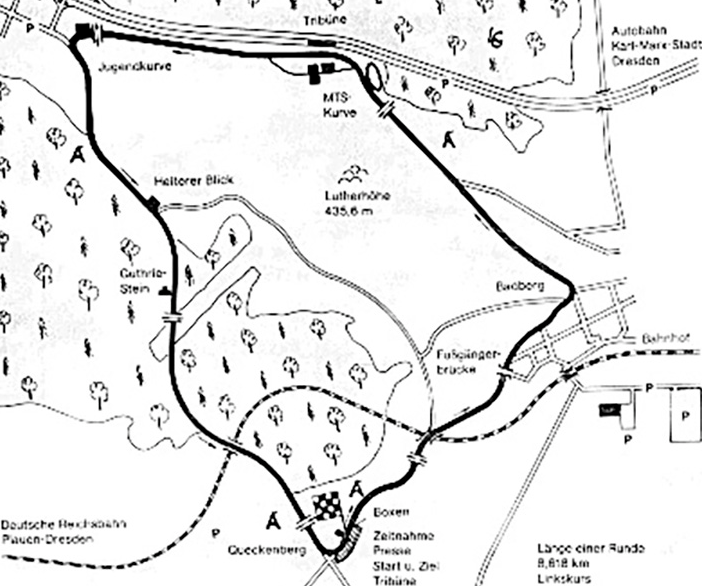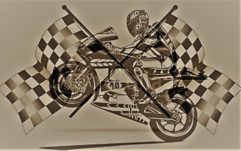
The GDR Grand Prix 50 years ago
While the preparations for a ghost race (except for a bunch of VIPs) at the Sachsenring are in full swing and sometimes even damp conditions are to be expected, we take a look back. Exactly 50 years ago, when Barry Sheene was only twenty-first and had just begun to make the world of international racing happy with his presence. The GDR Grand Prix was the sixth of 13 world championship races, and for the fourth time since 1967 all events took place only in Europe. At the time, the race at the Sachsenring was perhaps the most important sporting event behind the iron curtain. And unfortunately it was overshadowed by two events, one of which meant the imminent end of this race, which was incredibly popular in the area and far beyond the borders of Saxony and the GDR.

Günter Bartusch’s tragic accident
It was one of the most successful drivers in the GDR who tragically lost his life on July 9th at the start of the race weekend. Born on April 18, 1943 in nearby Freiberg (between Chemnitz and Dresden), three years earlier he had immediately finished third at his first Grand Prix behind the two Yamaha works riders Phil Read and Bill Ivy. For the MZ driver, it went on like this on his second international outing at the GP of the Czech Republic in Brno. Günter Bartusch took third place again and as a reward he was even allowed to contest four Grand Prix races the following year. The best result was a second place in Imatra (Finland) and with 12 points he was sixteenth in the World Cup in the 11-round season. A year later he started in three classes and took third place in the 125cc class at the French GP in Le Mans, as well as at the TT, which was then part of the World Cup (there also up to 250cc). In addition, at the Ulster GP up to 350cc, even a second place. After his tragic accident, some claimed that the engine of his MZ had got stuck with Bill Ivy on his Jawa two years earlier, but this was officially denied. Before the start of the race, the Saxon who died at the age of 28 was remembered with a minute’s silence.


The GDR Grand Prix of 1971
In the 125cc class, Angel Nieto (Derbi) won ahead of Barry Sheene (Suzuki) and the Swede Börje Jansson on the German brand Maico. In addition, the little Spaniard remained victorious in the so-called schnapps glass class up to 50cc on the make from his country, ahead of the two Dutchmen de Vries and Schurgers (both Kreidler). As so often in these years, Giacomo Agostini won the 350s on the vastly superior MV Agusta with 1’20.4 minutes ahead of Paul Smart (GB, Yamaha) and the Hungarian Laszlo Szabo was also almost 2 minutes behind on a Yamaha, the Italian. Except for two other drivers, the multiple world champion had lapped all the others when he saw the chequered flag.


The grotesque result of the 500cc Grand Prix of the GDR
In the premier class, “Ago nazionale” dominated even more dramatically, and only New Zealander Keith Turner on a Suzuki crossed the finish line on the same lap. If the winner is more than two and a half minutes ahead, the “decimal places” are completely unnecessary. The reason for this overwhelming superiority lay a few years ago, when the FIM decided to drastically change the regulations in response to pressure from the European plants without prior consultation with the Japanese plants. Honda had suddenly withdrawn from racing and would not return until more than a decade later. After the announcement of the change decided in February 1968 to the season in the following year, Suzuki also left together with Honda. However, the Hamamatsu factory returned to Grand Prix racing much earlier than the world’s largest motorcycle factory.

The wrong winner and above all the wrong anthem in the 250cc GP
The quarter-litre class race should go down in history for a number of reasons. As in the two smallest categories, it was exciting and dramatic right up to the end. And to the hardship of the countless party comrades present in the injustice state of the GDR, it was a “Wessie” of all people who played the role of the hero. Of course, the Swabians understood the Swabians particularly well when he spoke into the microphone, and his performance demanded all respect from even his opponents on this Sunday. From position 10, the tall man from Hermaringen had continuously worked his way forward. In the tenth round he took the lead and in the end it was the man from the land of the “class enemy” who was on top of the podium. Before the West German national anthem, the political functionaries even ensured that almost all loudspeakers, at least except for those at the start-finish line, were switched off. But with that they scored a goal of their own, because the enthusiastic fans from the majority of the GDR simply sang along themselves, which continued around the track. There was only one edition left in 1972 and then the GDR GP came to an end, thanks to the victory of a West German and above all stubborn party officials.

>GP Germany preview: see separate report on this page.

No Comments Yet